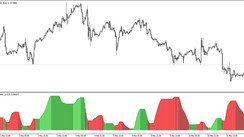These days, there’s practically no developed country that lacks a central bank, trying to achieve monetary stability of its country and avoid unexpected and significant price volatility as much as possible.
An unstable currency may have a negative impact not only on imports and exports of goods, but also on trading itself. If the currency is unstable and its exchange rate changes frequently, it’s very hard for the traders to set its value, thus having significant adverse consequences on the final balance of payments and balance in the books.
Therefore, central banks publish important information that should help the companies and traders in their future price estimates.
Important events incorporated in prices
Important news and events, central banks inform about, divide traders into two groups. One consists of those who believe that this news is already priced in the rates at the time of their publishing, so it’s useless to react on them. The other ones, conversely, base their future trading decisions on the basis of this news.
So, what’s the truth?
It’s clear that if there are companies and traders on the market, making their decisions on the basis of important news from central banks, it’s impossible for such news to be completely priced into the rates at the time of its publishing.
Another factor, standing against the theory that “everything is priced-in”, is the fact that central bank measures often lack immediate effect, but the market may react thereon in a couple of days or weeks and sometimes even months after their publishing.
A good example can be quantitative easing, performed by the Bank of Japan since 2013. It took more than a year Japanese yen dropped to the expected level.
That means that the traders, not ignoring the approach of the Bank of Japan and including it into their trading, could make a profit on it without even a year after the initiation.
How do central banks ensure price stability?
Interest rates
By the use of interest rates, most frequently, central banks intervene against rising inflation. In case inflation rises about a threshold, set by banks, interest rates are usually increased. Conversely, if inflation is found below the threshold, central banks tend to decrease interest rates (exchange rate usually drops ->, so other currencies are becoming more expensive) to boost the spending of consumers.
Quantitative easing
Quantitative easing is nothing difficult you should be afraid of. It’s simply a purchase of large volumes of assets by central banks, most of the time for newly issued money. In this way, central banks are trying to decrease long-term interest rates, thanks to which investment activity is boosted with subsequent economic growth.
So, how does it work?
For the central banks to be able to purchase assets, they need funds for such purchases, most of the time achieved by the printing of new money. For such, newly issued money, central banks make purchases from commercial banks (most often securities, bonds), thus providing new equity to commercial banks with low interest from central banks. Hereby, they rely on the fact that commercial banks rather invest such capital into the market with a high interest rate (corporate loans, leasing, …) instead of getting it from central banks ->> boost for investments.
Potential market impact of quantitative easing:
- As central banks buy new bonds or other assets, the price of these assets rises (price of bonds and stocks rises along with a potential rise of stock indices, …), and at the same time, their yield in percentage decreases.
- Quantitative easing may affect the value of stocks, even through new investments. As commercial banks acquire capital from central banks, they have the option to invest further, meaning that private companies may obtain new, often cheaper loans from commercial banks, thus having the possibility to form added value that could support not only their future profit, but also the price of stocks to rise.
Risks:
- When central banks declare the initiation of quantitative easing, usually it means the weakening of respective currencies
- Initiation of hyperinflation means that money can “burn” (losing their value very quickly) while in the past, after hyperinflation, a monetary reform came usually
- Market inflation may be transformed into certain segments where subsequently, a bubble occurs, and these instruments become less available (see the real estate market in the Czech Republic in these days) while in case of stocks, there’s the danger that companies declare default on their liabilities (usually, stock prices of such companies start to plunge after a problem with payment is declared)
- Indebtedness circle, being a consequence of quantitative easing, requires from the central bank to avoid the increase in interest rates and to keep them close to zero (on the one hand, low rates decrease the value of the currency, but guarantee an easier approach of the company to “new” capital; conversely, changes to interest rates often move foreign exchange rates as well). Otherwise, it could mean that less stable companies become indebted, ending in a secondary default
Approaches of central banks
Change in a long-term approach of a central bank, or only a hint of the fact that it could happen in the future, is just another factor that may bring volatility to exchange rates.
Exchange rate control
This is an artificial keeping of exchange rate above a certain price level. A good example is the keeping of Czech Koruna in the EUR/CZK pair by the Czech National Bank above the level of 27CZK. Since 2013, the Czech National Bank was decreasing the price of Koruna artificially by printing new money and exchanging it for EUR into its foreign exchange reserves. The consequence of price control tends to be that after a market cap removal, currencies strengthen markedly (as the case of Koruna) while Koruna strengthened to even 25CZK.
Conclusion
Approaches of central banks may provide a certain insight into the future development of exchange rates, and if the traders learn how to understand them, he may not only determine probable exchange rate direction but may be able to make a profit on it.
If you would like to try out trading with top tier trading conditions and professional forex broker, don’t hesitate to try our demo account that may be open on our website completely for free and free of any risk: www.purple-trading.com
We wish you many profitable trades!
About the Author

Team Purple Trading
Purple Trading is a true and 100% fair ECN / STP forex broker providing direct access to the real market. High speed orders execution, no trade-offs, no limits for any type of trading, the most advanced trading technologies. Explore more about Purple Trading at www.purple-trading.com .
CFDs are complex instruments and come with a high risk of losing money rapidly due to leverage. 72.1% of retail investors lose their capital when trading CFDs with this provider.
(This value was determined within the period from July 1, 2019, to June 30, 2020. You should consider whether you understand how CFDs work and whether you can afford to take the high risk of losing your money.
Trading forex exchange with margin carries a high level of risk and may not be suitable for all investors. The high degree of leverage can work against you as well as for you. Before deciding to trade foreign exchange, you should carefully consider your investment objectives, level of experience, and risk appetite. You could lose part or all of your initial investment and therefore you should not invest money that you cannot afford to lose. Seek independent advice if you have any doubts.
Any opinions, news, research, analysis, prices, or other information contained on this website is provided as general market commentary, and does not constitute investment advice. L.F. Investment Limited will not accept liability for any loss or damage, including without limitation to, any loss of profit, which may arise directly or indirectly from use of or reliance on such information.
Purple Trading is a trade name owned and operated by L.F. Investment Limited., a licensed Cyprus Investment Firm regulated by the CySEC lic. no. 271/15.





